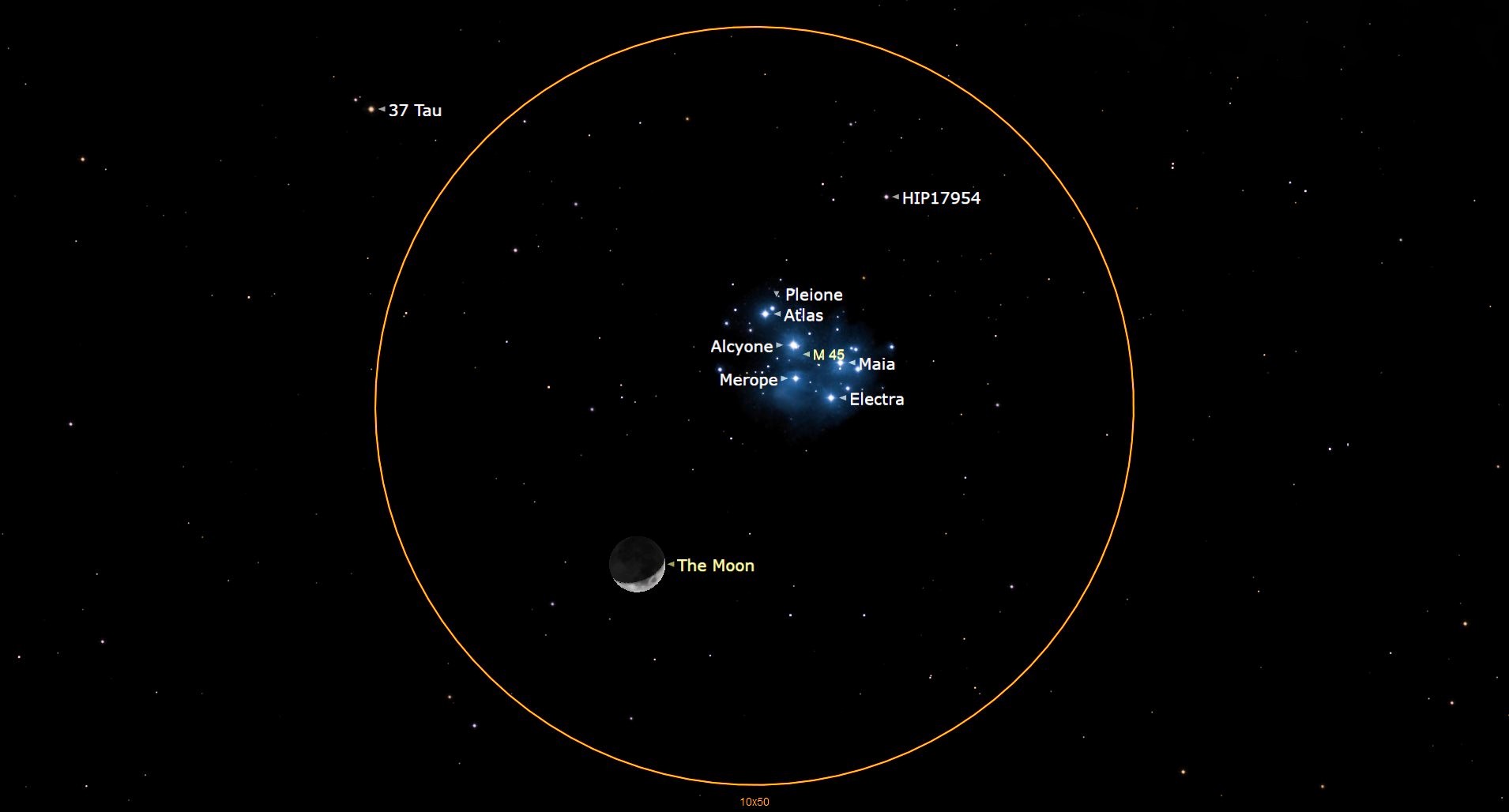See the moon shine next to the Pleiades star cluster tonight (March 25)
The waxing crescent moon will be close to the densely packed open star cluster also known as "the Seven Sisters" this weekend.

The moon will pass the star cluster the Pleiades or "the Seven Sisters" tonight (March 25).
According to NASA's What's Up Skywatching Highlights for March 2023, the waxing crescent moon will land next to this star cluster populated with bright blue stars as it continues the path upwards in the night sky it has been following in later March.
Appearing in the sky over the horizon to the west, from New York City the moon will sit to the right of the stars that make up the Seven Sisters at around 15:30 EDT (1930 GMT). According to In The Sky, from New York City, the moon will set in the west at around 00:02 EDT (0402 GMT) while the Pleiades, also known as Messier 45 (M45), sets just 7 minutes later at around 00:09 EDT (0409 GMT).
Related: Night sky, March 2023: What you can see tonight [maps]
Located around 440 light-years from Earth and visible in the constellation of Taurus the Pleiades is an open cluster comprised of around 1,000 stars. Of these, around six or seven are bright enough over Earth to be seen with the naked eye.
This has resulted in these stars playing a prominent role in myths and legends across different cultures. This includes Greek mythology in which the stars represent daughters of Atlas and Pleione, the Seven Sisters Alcyone, Maia, Electra, Merope, Taygete, Celaeno, and Sterope who were transformed into doves then stars by Zeus. These names are now assigned to the seven brightest individual stars in the Pleiades with two other bright stars named after their parents in Greek mythology.
With a mass equivalent to around 800 times that of the sun, the Pleiades cluster stretches for around 17.5 light-years, but the influence of its gravity, or its "tidal radius," extends for around 43 light-years.
Get the Space.com Newsletter
Breaking space news, the latest updates on rocket launches, skywatching events and more!

Looking for a telescope to see the planets in the night sky? We recommend the Celestron Astro Fi 102 as the top pick in our best beginner's telescope guide.
Even though young bright blue stars with ages estimated to be around 100 million years dominate the Pleiades from Earth there is actually a greater population of faint red stars among the Seven Sisters.
In addition to these red and blue stars, this open cluster is also populated with a multitude of brown dwarfs, making up as much as 25% of the mass of the Pleiades. These objects are also often referred to as "failed stars" because though they are larger than even massive gas giant planets they still lack the mass to trigger the nuclear fusion at their core that defines stars.
Another extraordinary feature of the Pleiades is the many "reflection nebulas" that surround the open cluster's stars. The result of dust reflecting starlight and glowing blue, these nebulas could be the remains of the gas and dust that formed the stars of the Pleiades. Alternatively, scientists believe the reflection nebulas could be material from a dust cloud in the interstellar material between stars and star clusters that the Pleiades is currently passing through.
If you're hoping to catch a look at the Pleiades during this close encounter with the waxing crescent moon our guides to the best telescopes and best binoculars are a great place to start. If you're looking to snap photos of the night sky in general, check out our guide on how to photograph the moon, as well as our best cameras for astrophotography and best lenses for astrophotography.
Editor's Note: If you snap an image of the Pleiades and would like to share it with Space.com's readers, send your photo(s), comments, and your name and location to spacephotos@space.com.
Join our Space Forums to keep talking space on the latest missions, night sky and more! And if you have a news tip, correction or comment, let us know at: community@space.com.

Robert Lea is a science journalist in the U.K. whose articles have been published in Physics World, New Scientist, Astronomy Magazine, All About Space, Newsweek and ZME Science. He also writes about science communication for Elsevier and the European Journal of Physics. Rob holds a bachelor of science degree in physics and astronomy from the U.K.’s Open University. Follow him on Twitter @sciencef1rst.









